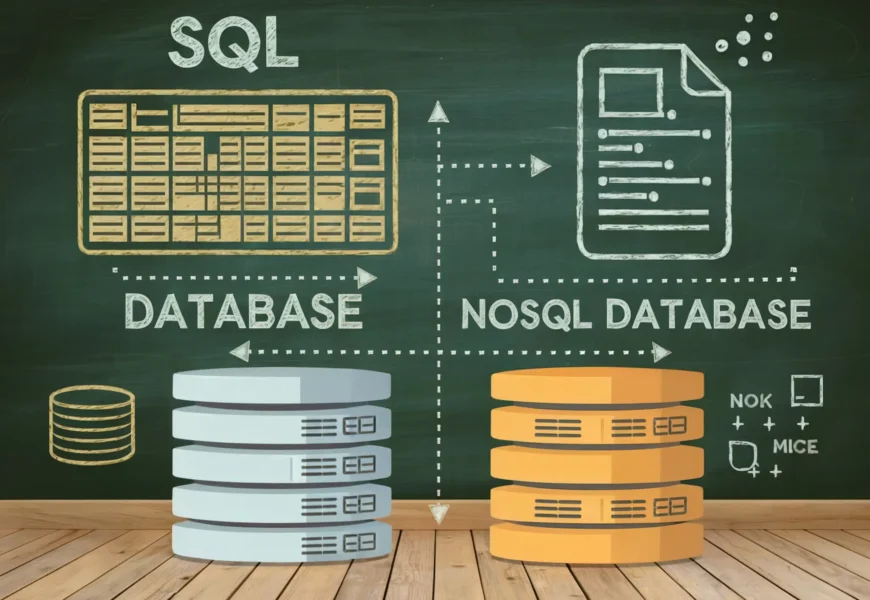In today’s data-driven world, selecting the appropriate database solution can make or break your project. Whether you’re a seasoned developer or a curious newcomer, understanding the nuances between SQL and NoSQL databases is crucial for making informed decisions. Did you know that by 2025, the global database management system market is expected to reach a staggering $63.8 billion? That’s huge!
Ah, the age-old debate of SQL vs. NoSQL databases! It’s like choosing between a Swiss Army knife and a specialized tool – both have their merits, but which one is right for you? As we dive into 2024, this question becomes more relevant than ever. With the exponential growth of data and the increasing complexity of applications, choosing the right database solution is no longer just a technical decision – it’s a strategic one that can significantly impact your project’s success.
In this comprehensive guide, we’ll explore the world of SQL and NoSQL databases, unraveling their mysteries and helping you make an informed decision for your next project. So, buckle up and get ready for a deep dive into the fascinating world of databases!
Understanding SQL Databases
Let’s start our journey by exploring the world of SQL databases. These tried-and-true stalwarts of the database world have been around for decades, and for good reason!
Definition and Core Concepts of SQL Databases
SQL databases, also known as relational databases, are based on the relational model introduced by E.F. Codd in 1970. At their core, SQL databases organize data into tables with predefined schemas, using relationships between these tables to create a structured and efficient data storage system.
The key to SQL databases is the use of Structured Query Language (SQL), a standardized language for managing and querying data. SQL provides a powerful and flexible way to interact with your data, allowing you to perform complex operations with relative ease.
Key Features of Relational Database Management Systems (RDBMS)
Relational Database Management Systems (RDBMS) are the software systems that manage SQL databases. They come packed with features that make them a go-to choice for many applications:
- ACID Compliance: ACID (Atomicity, Consistency, Isolation, Durability) properties ensure data integrity and reliability, making SQL databases ideal for applications that require strict data consistency.
- Structured Data Model: The predefined schema of SQL databases ensures data consistency and reduces redundancy.
- Powerful Querying: SQL’s rich querying capabilities allow for complex data retrieval and manipulation operations.
- Joins: The ability to combine data from multiple tables efficiently is a standout feature of SQL databases.
- Transactions: SQL databases support transactions, allowing multiple operations to be treated as a single unit of work.
Popular SQL Database Examples
Several SQL database systems have stood the test of time and continue to be widely used in 2024:
- MySQL: An open-source database that’s particularly popular for web applications.
- PostgreSQL: Known for its extensibility and compliance with SQL standards.
- Oracle: A commercial database system often used in large enterprise applications.
- Microsoft SQL Server: Microsoft’s offering in the SQL database space, is tightly integrated with their other products.
- SQLite: A lightweight, serverless database often used in mobile and desktop applications.
Strengths and Use Cases for SQL Databases
SQL databases shine in many scenarios, particularly where data integrity and complex querying are paramount. Here are some of their key strengths:
- Data Integrity: The rigid structure of SQL databases ensures data consistency and reduces errors.
- Complex Queries: SQL excels at handling complex queries involving multiple tables and large datasets.
- Transactions: For applications that require ACID compliance, SQL databases are often the go-to choice.
- Standardization: SQL is a standardized language, making it easier to find developers and tools.
Common use cases for SQL databases include:
- Financial systems
- E-commerce platforms
- Content management systems
- Customer relationship management (CRM) systems
- Enterprise resource planning (ERP) systems
Exploring NoSQL Databases
Now that we’ve covered SQL databases, let’s venture into the exciting world of NoSQL databases. These newer kids on the block have been making waves in the database community, offering flexibility and scalability that traditional SQL databases sometimes struggle with.
Definition and Types of NoSQL Databases
NoSQL, which stands for “Not Only SQL,” refers to a broad class of database management systems that differ from the traditional relational model. NoSQL databases are designed to handle large volumes of unstructured or semi-structured data, offering more flexibility in terms of data models and scalability.
There are several types of NoSQL databases, each with its own strengths:
- Document Databases: Store data in flexible, JSON-like documents (e.g., MongoDB, CouchDB)
- Key-Value Stores: Simple databases that store data as key-value pairs (e.g., Redis, Amazon DynamoDB)
- Wide-Column Stores: Store data in tables with rows and columns, but with more flexible schemas (e.g., Cassandra, HBase)
- Graph Databases: Designed for data with complex relationships (e.g., Neo4j, Amazon Neptune)
Key Features and Benefits of Non-Relational Databases
NoSQL databases come with a host of features that make them attractive for certain use cases:
- Flexibility: NoSQL databases often have flexible schemas, allowing for easier changes to the data model.
- Scalability: Many NoSQL databases are designed to scale horizontally, making it easier to handle large amounts of data and traffic.
- Performance: For certain operations, NoSQL databases can offer better performance than traditional SQL databases.
- Handling Unstructured Data: NoSQL databases excel at storing and querying unstructured or semi-structured data.
- Eventual Consistency: Many NoSQL databases offer eventual consistency models, which can improve performance in distributed systems.
Popular NoSQL Database Examples
Some of the most popular NoSQL databases in 2024 include:
- MongoDB: A document-based database known for its flexibility and ease of use.
- Cassandra: A wide-column store designed for high availability and scalability.
- Redis: An in-memory key-value store often used for caching and real-time applications.
- Neo4j: A graph database ideal for handling complex relationships between data points.
- Amazon DynamoDB: A fully managed NoSQL database service offered by AWS.
Strengths and Use Cases for NoSQL Databases
NoSQL databases have several strengths that make them ideal for certain scenarios:
- Scalability: Many NoSQL databases are designed to scale horizontally, making them suitable for applications with large amounts of data or high traffic.
- Flexibility: The schema-less nature of many NoSQL databases allows for easier changes to the data model.
- Performance: For certain types of queries, particularly those involving large amounts of unstructured data, NoSQL databases can offer superior performance.
- Handling Big Data: NoSQL databases are often better suited for handling the volume, velocity, and variety of big data.
Common use cases for NoSQL databases include:
- Real-time web applications
- Internet of Things (IoT) data storage
- Content delivery networks
- Gaming applications
- Social networks and user data storage
SQL vs. NoSQL: Key Differences
Now that we’ve explored both SQL and NoSQL databases, let’s compare them head-to-head. Understanding these key differences will help you make an informed decision when choosing a database solution for your project.
Data Model and Schema Flexibility
One of the most significant differences between SQL and NoSQL databases lies in their approach to data modeling and schema design.SQL Databases:
- Use a rigid, predefined schema
- Data is organized into tables with fixed columns
- Changes to the schema can be complex and time-consuming
- Ensure data integrity through constraints and relationships
NoSQL Databases:
- Often schema-less or have flexible schemas
- Data models vary (document, key-value, wide-column, graph)
- Can easily accommodate changes to the data structure
- May sacrifice some data integrity for flexibility
Scalability and Performance Characteristics
Scalability is a crucial factor in choosing a database, especially for applications expected to handle large amounts of data or traffic.SQL Databases:
- Typically scale vertically (adding more power to a single server)
- Can be challenging to scale horizontally (across multiple servers)
- May face performance issues with very large datasets
NoSQL Databases:
- Often designed for horizontal scalability
- Can handle large amounts of data and traffic more easily
- May offer better performance for certain types of queries and data access patterns
ACID Compliance and Data Consistency
ACID compliance is a set of properties that guarantee database transactions are processed reliably.SQL Databases:
- Fully ACID compliant
- Ensure strong consistency
- Ideal for applications requiring high data integrity (e.g., financial systems)
NoSQL Databases:
- Many offer eventual consistency rather than strong consistency
- Some NoSQL databases are ACID compliant, but it’s not universal
- May sacrifice some consistency for improved performance and scalability
Query Language and Complexity
The way you interact with and query the database differs significantly between SQL and NoSQL systems.SQL Databases:
- Use standardized SQL for querying
- Support complex queries, including joins across multiple tables
- Have a steep learning curve but offer powerful querying capabilities
NoSQL Databases:
- Often have their own query languages or APIs
- May not support complex joins natively
- Generally easier to learn but may be less powerful for complex queries
Use Cases and Industry Adoption
While both SQL and NoSQL databases have their place, they tend to excel in different scenarios.SQL Databases:
- Widely adopted in industries requiring complex queries and transactions
- Ideal for applications with complex relationships between data entities
- Common in financial services, e-commerce, and traditional enterprise applications
NoSQL Databases:
- Gaining popularity in web, mobile, and IoT applications
- Excel in handling large volumes of unstructured or semi-structured data
- Often used in real-time big data applications, content management systems, and social networks
Factors to Consider When Choosing a Database Solution
Choosing between SQL and NoSQL databases isn’t a one-size-fits-all decision. Here are some crucial factors to consider when making your choice:
Project Requirements and Scalability Needs
- What are your current data storage needs?
- How much do you expect your data to grow in the future?
- Do you need to handle sudden spikes in traffic or data volume?
If you’re building an application that needs to handle massive amounts of data or traffic, or if you anticipate rapid growth, a NoSQL database might be more suitable due to its easier horizontal scalability. On the other hand, if your data volume is more predictable and you need strong consistency, an SQL database could be the better choice.
Data Structure and Relationships
- Is your data structured, semi-structured, or unstructured?
- Are there complex relationships between different data entities?
- How often do you expect your data model to change?
SQL databases excel when dealing with structured data and complex relationships between entities. If your data fits neatly into tables and you need to perform complex joins, SQL is likely the way to go. However, if your data is unstructured or you need more flexibility in your data model, a NoSQL database might be more appropriate.
Query Complexity and Performance Expectations
- What types of queries will you be running most often?
- Do you need to perform complex analytics on your data?
- What are your performance requirements for read-and-write operations?
SQL databases are generally better at handling complex queries, especially those involving multiple tables. If you need to perform a lot of complex analytics or reporting, SQL might be the better choice. NoSQL databases, on the other hand, can often provide better performance for simpler queries, especially at scale.
Development Team Expertise and Familiarity
- What database technologies is your team most familiar with?
- Do you have the resources to train your team on a new database technology if needed?
The learning curve associated with adopting a new database technology can be significant. If your team is already proficient in SQL, switching to a NoSQL database might require substantial training and adjustment. Conversely, if your team is more experienced with NoSQL technologies, adopting an SQL database could slow down development.
Budget and Resource Constraints
- What is your budget for database licensing, hardware, and maintenance?
- Do you have the resources to manage and scale your database infrastructure?
Some NoSQL databases offer free, open-source versions, which can be attractive for startups or projects with limited budgets. However, enterprise-grade support and features often come with a cost. SQL databases, particularly enterprise versions, can be expensive but often come with robust support and features out of the box.
Real-World Applications and Case Studies
To better understand how SQL and NoSQL databases are used in practice, let’s look at some real-world applications and case studies.
Examples of Successful SQL Database Implementations
- Banking Systems: Many banks rely on SQL databases for their core banking systems due to the need for ACID compliance and complex transaction management. For example, Bank of America uses Oracle’s relational database to manage its vast array of financial data and transactions.
- E-commerce Platforms: Amazon’s early infrastructure was built on Oracle’s relational databases, handling complex product catalogs, order processing, and inventory management.
- Healthcare Systems: Electronic Health Record (EHR) systems often use SQL databases to ensure data integrity and support complex queries. Epic Systems, a major EHR provider, uses InterSystems Caché, a specialized SQL database.
Case Studies of NoSQL Database Adoption
- Netflix: Netflix uses Apache Cassandra, a NoSQL database, to handle its massive amount of user data and viewing history. This allows them to scale horizontally and provide personalized recommendations to millions of users.
- Facebook: Facebook uses a combination of NoSQL databases, including Apache Cassandra for its Instagram platform and a custom-built graph database called TAO for managing social connections.
- Airbnb: Airbnb uses MongoDB, a document-based NoSQL database, to store and manage listing data. This allows them to easily handle the varied and complex data associated with property listings.
Hybrid Approaches: Combining SQL and NoSQL Solutions
Many organizations are finding success with hybrid approaches, combining the strengths of both SQL and NoSQL databases:
- Uber: Uber uses a combination of MySQL (SQL) for transactional data and Cassandra (NoSQL) for real-time analytics and tracking.
- eBay: eBay uses Oracle databases for transactional data and MongoDB for managing item listings, allowing them to balance consistency and flexibility.
- The New York Times: The newspaper uses a combination of MySQL for its content management system and MongoDB for storing and serving articles, allowing for both structured data management and flexible content storage.
Industry Trends and Future Outlook
As we look to the future, several trends are shaping the database landscape:
- Cloud-Native Databases: Both SQL and NoSQL databases are increasingly being offered as fully managed cloud services, reducing the operational overhead for organizations.
- Multi-Model Databases: Some databases are beginning to support multiple data models within a single system, blurring the lines between SQL and NoSQL.
- AI and Machine Learning Integration: Databases are increasingly integrating AI and machine learning capabilities, enabling more intelligent data management and analytics.
- Edge Computing: With the rise of IoT and edge computing, databases that can operate effectively in distributed environments are gaining importance.
- Blockchain and Distributed Ledger Technologies: These technologies are introducing new paradigms in data storage and management, potentially influencing future database designs.
Conclusion
Choosing between SQL and NoSQL databases isn’t a one-size-fits-all decision – it’s about finding the perfect fit for your project’s unique requirements. By understanding the strengths and limitations of each database type, you can make an informed decision that sets your project up for success.
Remember, the best database solution is the one that aligns with your specific needs, scalability requirements, and long-term goals. Consider factors such as your data structure, query complexity, scalability needs, and team expertise when making your decision.In many cases, a hybrid approach combining both SQL and NoSQL databases might be the optimal solution, allowing you to leverage the strengths of each technology where it’s most appropriate.
As we move further into 2024 and beyond, the database landscape will continue to evolve. Stay informed about emerging trends and technologies, and be prepared to adapt your database strategy as needed.
So, are you ready to make the right choice for your data-driven future? The power is in your hands! Whether you choose SQL, NoSQL, or a hybrid approach, remember that your database is the foundation of your application. Choose wisely, and may your data always be organized, accessible, and ready to drive your success!














